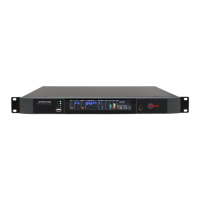Orban 5950 Technical Manual Operation 3-9
when measured on a Belar FMSA-1 “Wizard” modulation monitor, which was originally designed for convention
double sideband operation.
However, there are consumer-based radios and car audio systems which detect the missing upper sideband and
misinterpret this as a signal issue and blend towards mono. Other systems will develop distortion because of the
increased amplitude in the lower sideband which is needed to allow the system to work at all. This distortion
manifests itself as a headroom issue. Before applying the system, engineering, programming and management
should be aware of the tradeoffs using SSB/VSB mode vs DSB operation.
In SSB/VSB mode, the bandwidth of the 5950’s composite output signal extends to 38,150 Hz when the 5950’s
composite limiter is not used. When the composite limiter is used, the limiting action will produce energy up to 55
kHz (as it does with normal DSB operation) but this energy will be much lower in level than the energy that would
have been produced by normal DSB operation in the frequency range occupied by the upper sideband.
SSB operation causes irreducible, “laws of physics” composite peak modulation overshoots to occur with certain
combinations of left and right channel signals that are independently peak limited to 100% modulation, which is
the correct limiting technique for conventional double-sideband transmission. The worst-case irreducible SSB
overshoot occurs when the left and right channels contain correlated signals whose phase difference is 90q. The
5950’s Multipath Mitigator, which removes inter-channel phase shifts and converts input audio to “intensity
stereo,” is important to optimum SSB/VSB operation because its action minimizes the amount of modulation
overshoot.
Suboptimal system design can cause additional overshoots. To prevent this type of overshoot, the 5950’s SSB/VSB
generator uses constant-delay filters and its frequency response extends to DC (because of the VSB operation
below 150 Hz).
To control irreducible overshoots, the SSB generator includes a look-ahead overshoot limiter. To eliminate all
overshoots, this limiter must be used together with the 5950’s Half-Cosine Interpolation composite limiter, which
is located after the look-ahead limiter in the system block diagram.
The group delay of the phase-linear filters needed to create the SSB/VSB waveform and the audio delay in the
look-ahead limiter together add approximately 12 ms to the delay of the stereo encoder. When diversity delay is
applied to the 5950’s composite output, the 5950 adjusts the delay automatically so that it is constant regardless
of mode.
SSB stereo encoder mode can be selected from the MODULATION TYPE drop-down in the INPUT/OUTPUT >
COMPOSITE screen. Choose SSB to turn on SSB/VSB operation or STEREO to turn on normal DSB operation. It can
also be controlled via the 5950’s GPI inputs and by PC Remote.
The look-ahead overshoot controller is always active in SSB mode, while the Half Cosine Interpolation Composite
Limiter is controlled by the COMPOSITE LIMIT DRIVE control as usual.
Composite Limiter/Clipper: Orban has traditionally opposed composite clipping because of its tendency to
interfere with the stereo pilot tone and with subcarriers, and because it causes inharmonic aliasing distortion,
particularly between the stereo main and subchannels. Protecting the pilot tone and subcarrier regions is
particularly difficult with a conventional composite clipper because appropriate filters will not only add overshoot

